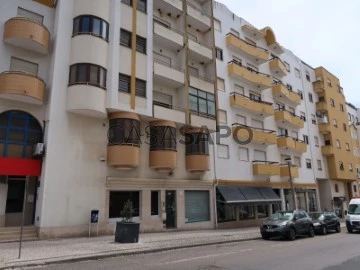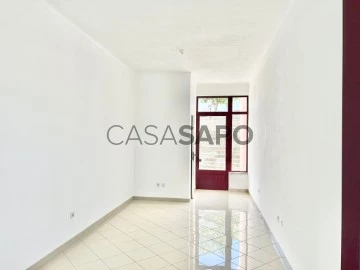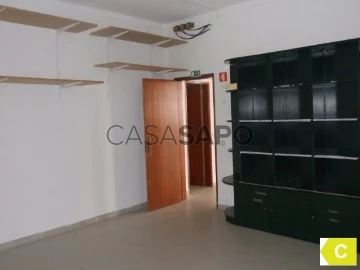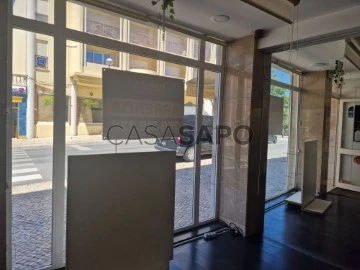Shops
Rooms
Price
More filters
5 Shops - Shop Used, for Sale, in Distrito de Setúbal, Santiago do Cacém, S.Cruz e S.Bartolomeu da Serra
Map
Order by
Relevance
Shop
Santiago do Cacém, Santiago do Cacém, S.Cruz e S.Bartolomeu da Serra, Distrito de Setúbal
Used · 160m²
buy
170.000 €
Apresentamos um excelente espaço comercial para venda, localizado numa zona central e de fácil acesso.
Este imóvel, com uma fachada discreta mas funcional, é ideal para diversos tipos de negócios.
A entrada é ampla e acolhedora, garantindo uma boa visibilidade e acessibilidade para clientes.
No interior, o espaço é distribuído de forma a permitir uma utilização versátil, com áreas distintas que podem ser adaptadas conforme as necessidades do seu negócio.
O imóvel encontra-se em bom estado de conservação, pronto a ser utilizado sem necessidade de grandes intervenções. Além disso, a área circundante oferece várias comodidades, incluindo estacionamento e fácil acesso a transportes públicos.
Esta é uma oportunidade imperdível para estabelecer ou expandir o seu negócio num local privilegiado. Contacte-nos para mais informações e para agendar uma visita.
Não perca esta oportunidade de investimento!
Este imóvel, com uma fachada discreta mas funcional, é ideal para diversos tipos de negócios.
A entrada é ampla e acolhedora, garantindo uma boa visibilidade e acessibilidade para clientes.
No interior, o espaço é distribuído de forma a permitir uma utilização versátil, com áreas distintas que podem ser adaptadas conforme as necessidades do seu negócio.
O imóvel encontra-se em bom estado de conservação, pronto a ser utilizado sem necessidade de grandes intervenções. Além disso, a área circundante oferece várias comodidades, incluindo estacionamento e fácil acesso a transportes públicos.
Esta é uma oportunidade imperdível para estabelecer ou expandir o seu negócio num local privilegiado. Contacte-nos para mais informações e para agendar uma visita.
Não perca esta oportunidade de investimento!
Contact
Shop
Santiago do Cacém, S.Cruz e S.Bartolomeu da Serra, Distrito de Setúbal
Used · 33m²
buy
31.000 €
Imóvel localizado em zona consolidada, residencial de 1ª habitação. Localiza-se em Santiago de Cacém, na saída para Grândola, em zona com oferta diversificada de comércio e serviços e transportes públicos. O estacionamento é realizado na via. Bons acessos às vias principais pela N 120 e N 261 que permitem a ligação à A26.
A loja, está inserida na Cave de um prédio urbano em regime de propriedade horizontal, composto por um total de 5 pisos, sendo as duas subcaves destinadas a parqueamento e arrumos, Cave e R/C destinados a comércio e serviços e os restantes 2 pisos destinados a habitação.
A loja de (33 m²) tem associada uma arrecadação (4 m²), na Sub-Cave.
A loja, está inserida na Cave de um prédio urbano em regime de propriedade horizontal, composto por um total de 5 pisos, sendo as duas subcaves destinadas a parqueamento e arrumos, Cave e R/C destinados a comércio e serviços e os restantes 2 pisos destinados a habitação.
A loja de (33 m²) tem associada uma arrecadação (4 m²), na Sub-Cave.
Contact
Shop
Santiago do Cacém, S.Cruz e S.Bartolomeu da Serra, Distrito de Setúbal
Used · 23m²
buy
26.000 €
Imóvel localizado em zona consolidada, residencial de 1ª habitação. Localiza-se em Santiago de Cacém, na saída para Grândola, em zona com oferta diversificada de comércio e serviços e transportes públicos. O estacionamento é realizado na via. Bons acessos às vias principais pela N 120 e N 261 que permitem a ligação à A26.
A loja, está inserida na Cave de um prédio urbano em regime de propriedade horizontal, composto por um total de 5 pisos, sendo as duas subcaves destinadas a parqueamento e arrumos, Cave e R/C destinados a comércio e serviços e os restantes 2 pisos destinados a habitação.
A loja de (23 m²), denominada por Fração D, tem na Subcave um lugar de estacionamento (12 m²) e uma arrecadação (2 m²).
A loja, está inserida na Cave de um prédio urbano em regime de propriedade horizontal, composto por um total de 5 pisos, sendo as duas subcaves destinadas a parqueamento e arrumos, Cave e R/C destinados a comércio e serviços e os restantes 2 pisos destinados a habitação.
A loja de (23 m²), denominada por Fração D, tem na Subcave um lugar de estacionamento (12 m²) e uma arrecadação (2 m²).
Contact
Shop
Santiago do Cacém, Santiago do Cacém, S.Cruz e S.Bartolomeu da Serra, Distrito de Setúbal
Used · 61m²
buy
90.000 €
Loja em Santiago do Cacém, com área de 61,85 m2, localização centro da cidade
Estamos disponíveis para ajudá-lo na obtenção do seu Crédito Habitação, pois somos Intermediários de Crédito Vinculado, registados no Banco de Portugal sob o nº 0003106.
Prestamos um serviço de acompanhamento antes e depois da sua escritura.
Estamos disponíveis para ajudá-lo na obtenção do seu Crédito Habitação, pois somos Intermediários de Crédito Vinculado, registados no Banco de Portugal sob o nº 0003106.
Prestamos um serviço de acompanhamento antes e depois da sua escritura.
Contact
Shop
Santiago do Cacém, S.Cruz e S.Bartolomeu da Serra, Distrito de Setúbal
Used · 148m²
buy
120.000 €
Excellent shop in prime area of Santiago do Cacém.
Close to the Town Hall and the city garden, here is your opportunity to move forward with your business.
It has a generous basement.
Bank Financing:
Habita is a partner of several financial entities enabling all its customers free simulations of Housing Credit.
location:
Santiago do Cacém is a Portuguese city in the District of Setúbal, is the headquarters of one of the largest municipalities in Portugal, with an area of 1,059.77 km².
It is home to one of the largest municipalities in Portugal, with 1,059.77 km² of area and 29,749 inhabitants (2015 INE), subdivided into 8 parishes.
The municipality is bordered to the north by the term of Grândola, to the northeast by Ferreira do Alentejo, to the east by Aljustrel, to the south by Ourique and Odemira and to the west by Sines and has coastline in the Atlantic Ocean. It is the only municipality in the entire Alentejo that contains 2 cities within its term (Santiago and Santo André). It also has three villages (Cercal, Alvalade and Ermidas-Sado).
history:
Its name derives from The Mooring Governor Kassim and the Order of Santiago.
Endorsed in a strategic geographical location, human populations have sought this region since remote times to establish itself. The excavations carried out in the Old Castle, where the Roman ruins of Miróbriga are located, show that the region has been inhabited since prehistory.
The ruins of Miróbriga represent one of the most striking traces of the occupation of the Romans in southwestern Portugal.
It was classified as a Property of Public Interest in 1940. The Roman city stretches for more than 2 km, featuring ruins of housing buildings, paved streets, a racetrack, a bathing, a bridge and a forum.
With Roman colonization, it developed into the commercial area around the forum. The termes, among the best preserved in Portugal. Relatively close to the terme, there is a bridge with a single semicircular arch. The hippodrome is the only fully known in Portuga and is located farther from the center.
It was around 712 and already after the decline of Miróbriga that the Moors reached the territory, building the castle on the hill in front; it is even thought that the name Kassem will be linked to the Mooring villager. The Moorish occupation lasted until the 19th century. XII and many battles for the reconquest took place in the territory until, in 1217, he returned definitively to the possession of Christians, and D. Afonso II confirmed the donation of his father to the Order of Skewers.
economy:
In the municipality, activities related to the primary sector predominate, followed by secondary and tertiary activities.
Agriculture still maintains great importance, with 43.9% of the municipality’s area destined for agricultural exploration, especially the cultivation of cereals for grain, temporary grassland and forage crops, industrial crops, pousio, olive groves, grassland and permanent pastures.
Livestock farming is also of some importance, particularly in the breeding of birds, sheep and pigs.
About 7785 hectares of its territory are covered with forest.
Thus, agriculture, swine farming and rice husking are the most important activities, followed by industry, namely self-catering workshops, civil construction, civil locksmithing, marble processing, wood sawing and cork processing.
Culture and leisure:
There are many popular and cultural manifestations in the county: the feast of Our Lady of Grace, held on the last Sunday of May, with various religious ceremonies, namely prayer meetings, and the annual fairs, on the fourth Sunday of April and the fourth Sunday of July; Santiagro, ’Agricultural Fair’, in May, of economic and cultural promotion; FATAL - Alentejo Coastal Handicraft and Tourism Fair; the traditional Green Grass festivals, both in July; the Monte Fair in September; the traditional festivals of Aldeia dos Chãos in August and The Day of the Municipality, on July 25.
In handicrafts, we highlight the latoaria works, lace, embroidery, clay and cork work, tapestry and wood.
As a cultural installation, the municipality has the Municipal Museum of Santiago do Cacém, in which the numismatics and archeology sections are to be taken up, the latter representative of human occupation in the region, since the times of the Upper Paleolithic. In the collection of ethnography, highlight the traditional Alentejo cuisine, which joins the recreation of a popular room, which makes counterpoint with another of markedly bourgeois taste and which is part of a remarkable legacy of one of the families of the region - the Counties of Avillez.
In 1895 the first automobile arrived in Portugal, owned by the Count of Avilez, santiago do Cacém;
The title of curiosity, also the 1st Rolls Royce that came to Portugal, came to Santiago do Cacém, owned by José Sande Champalimaud and the car registration with no. 1, in 1904, went also to Santiago do Cacém, on behalf of Augusto Teixeira de Aragão.
Points to visit:
- Castle of Santiago do Cacém
- Miróbriga Archaeological Station
- Municipal Museum of Santiago do Cacém
- Castle of Santiago do Cacém
- Badoca Safari Park
- Medieval Alvalade Bridge
- Old Castle area with the ruins of the Roman city Miróbriga
- Church of Santiago or Mother Church of Santiago do Cacém
Close to the Town Hall and the city garden, here is your opportunity to move forward with your business.
It has a generous basement.
Bank Financing:
Habita is a partner of several financial entities enabling all its customers free simulations of Housing Credit.
location:
Santiago do Cacém is a Portuguese city in the District of Setúbal, is the headquarters of one of the largest municipalities in Portugal, with an area of 1,059.77 km².
It is home to one of the largest municipalities in Portugal, with 1,059.77 km² of area and 29,749 inhabitants (2015 INE), subdivided into 8 parishes.
The municipality is bordered to the north by the term of Grândola, to the northeast by Ferreira do Alentejo, to the east by Aljustrel, to the south by Ourique and Odemira and to the west by Sines and has coastline in the Atlantic Ocean. It is the only municipality in the entire Alentejo that contains 2 cities within its term (Santiago and Santo André). It also has three villages (Cercal, Alvalade and Ermidas-Sado).
history:
Its name derives from The Mooring Governor Kassim and the Order of Santiago.
Endorsed in a strategic geographical location, human populations have sought this region since remote times to establish itself. The excavations carried out in the Old Castle, where the Roman ruins of Miróbriga are located, show that the region has been inhabited since prehistory.
The ruins of Miróbriga represent one of the most striking traces of the occupation of the Romans in southwestern Portugal.
It was classified as a Property of Public Interest in 1940. The Roman city stretches for more than 2 km, featuring ruins of housing buildings, paved streets, a racetrack, a bathing, a bridge and a forum.
With Roman colonization, it developed into the commercial area around the forum. The termes, among the best preserved in Portugal. Relatively close to the terme, there is a bridge with a single semicircular arch. The hippodrome is the only fully known in Portuga and is located farther from the center.
It was around 712 and already after the decline of Miróbriga that the Moors reached the territory, building the castle on the hill in front; it is even thought that the name Kassem will be linked to the Mooring villager. The Moorish occupation lasted until the 19th century. XII and many battles for the reconquest took place in the territory until, in 1217, he returned definitively to the possession of Christians, and D. Afonso II confirmed the donation of his father to the Order of Skewers.
economy:
In the municipality, activities related to the primary sector predominate, followed by secondary and tertiary activities.
Agriculture still maintains great importance, with 43.9% of the municipality’s area destined for agricultural exploration, especially the cultivation of cereals for grain, temporary grassland and forage crops, industrial crops, pousio, olive groves, grassland and permanent pastures.
Livestock farming is also of some importance, particularly in the breeding of birds, sheep and pigs.
About 7785 hectares of its territory are covered with forest.
Thus, agriculture, swine farming and rice husking are the most important activities, followed by industry, namely self-catering workshops, civil construction, civil locksmithing, marble processing, wood sawing and cork processing.
Culture and leisure:
There are many popular and cultural manifestations in the county: the feast of Our Lady of Grace, held on the last Sunday of May, with various religious ceremonies, namely prayer meetings, and the annual fairs, on the fourth Sunday of April and the fourth Sunday of July; Santiagro, ’Agricultural Fair’, in May, of economic and cultural promotion; FATAL - Alentejo Coastal Handicraft and Tourism Fair; the traditional Green Grass festivals, both in July; the Monte Fair in September; the traditional festivals of Aldeia dos Chãos in August and The Day of the Municipality, on July 25.
In handicrafts, we highlight the latoaria works, lace, embroidery, clay and cork work, tapestry and wood.
As a cultural installation, the municipality has the Municipal Museum of Santiago do Cacém, in which the numismatics and archeology sections are to be taken up, the latter representative of human occupation in the region, since the times of the Upper Paleolithic. In the collection of ethnography, highlight the traditional Alentejo cuisine, which joins the recreation of a popular room, which makes counterpoint with another of markedly bourgeois taste and which is part of a remarkable legacy of one of the families of the region - the Counties of Avillez.
In 1895 the first automobile arrived in Portugal, owned by the Count of Avilez, santiago do Cacém;
The title of curiosity, also the 1st Rolls Royce that came to Portugal, came to Santiago do Cacém, owned by José Sande Champalimaud and the car registration with no. 1, in 1904, went also to Santiago do Cacém, on behalf of Augusto Teixeira de Aragão.
Points to visit:
- Castle of Santiago do Cacém
- Miróbriga Archaeological Station
- Municipal Museum of Santiago do Cacém
- Castle of Santiago do Cacém
- Badoca Safari Park
- Medieval Alvalade Bridge
- Old Castle area with the ruins of the Roman city Miróbriga
- Church of Santiago or Mother Church of Santiago do Cacém
Contact
See more Shops - Shop Used, for Sale, in Distrito de Setúbal, Santiago do Cacém, S.Cruz e S.Bartolomeu da Serra
Bedrooms
Zones
Can’t find the property you’re looking for?
























